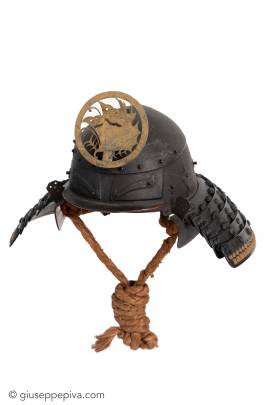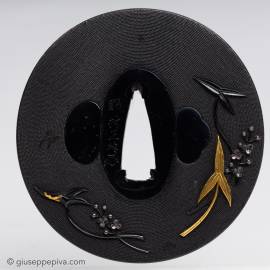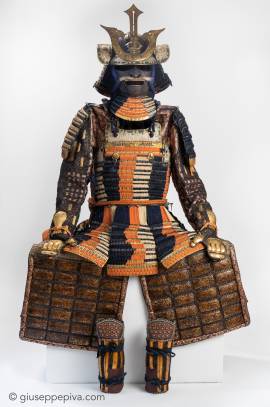Samurai helmet shaped as a head towelSaika, early Edo period, 17th centuryKōshu-Tokubetsu-Kichō-Shiryō certificate The Haruta armourers who moved to Kii province in the early 17th century, took the name from the village where they worked, Saika, near Wakayama, possibly on request of the local daimyō, Asano Yukinaga, a great armour amateur. Specialised in the construction of plate helmets, they produced mainly two typologies of kabuto: one with six plates covered with a chrysanthemum-shaped plate on top and one shaped as a “head towel”, called okitenugui. The latter type...
WORKS FOR SALE
Signed Nomura Masahide (野村 正 英) with kaoEdo period, 18th-19th centuryMarugata: 7.49 x 7.3 cmThickness: 4.3 mmNBTHK Tokubetsu Hozon Tosogu The Nomura school was founded by Kozaemon Masatoki, who studied with Gotō school artists and maintained their stylistic features, producing works in shakudo nanako with subjects in takabori. Due to this resemblance some sources refer to the Nomura school as "Awa-Gotō". The school's production originally included all kinds of sword fittings with the exception of tsuba, which begun to be made only in the second part of the Edo period....
Early Edo period, 17th-18th centuryCertificate:This authentic samurai armor is accompanied by a certificate of registration as Koshu Tokubetsu Kicho Shiryo (Especially Important Armor Object) no. 1277 issued by the Nihon Katchu Bugu Kenkyu Hozon Kai (Japanese Armor Preservation Society), 2020.11.01 This flamboyant Samurai armor is entirely made in true scale (hon-kozane), lacquered in black and gold and laced with blue, orange and white silk, in order to create a pattern of multiple colours,The helmet (kabuto) is of suji-bachi construction, made of 62 plates, with...
Copyright © 2016 - giuseppe piva - VAT: 05104180962










